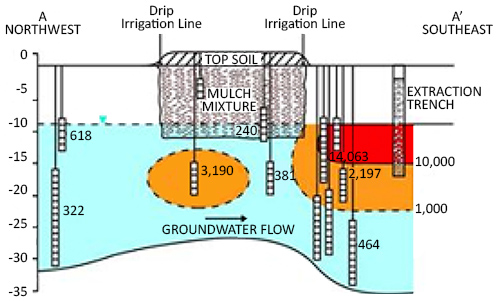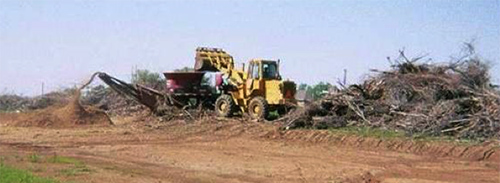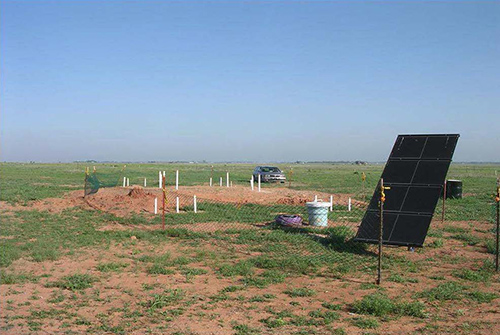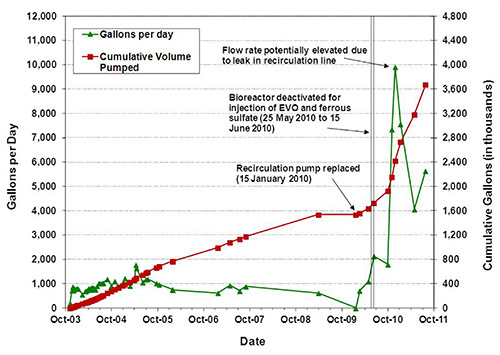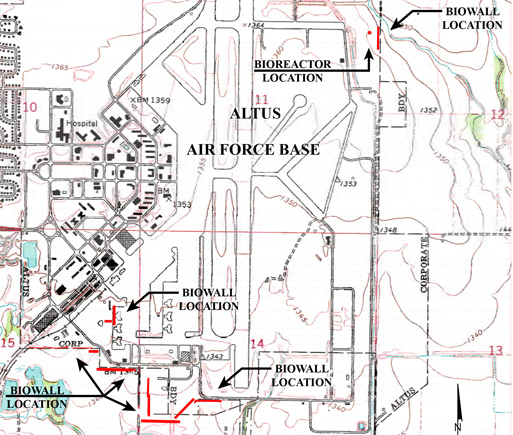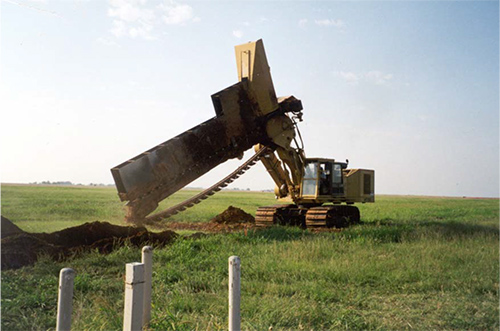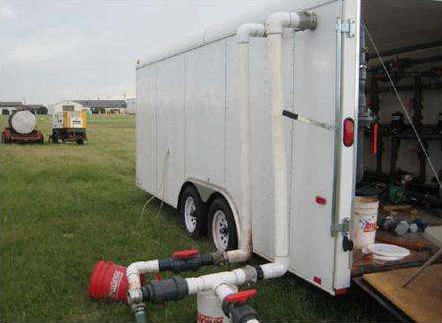Green Remediation Focus
Altus Air Force Base
Altus, Oklahoma
Federal Facility, RCRA Corrective Action
Cleanup Objectives: Reduce groundwater concentrations of chlorinated aliphatic hydrocarbons near a closed landfill and in several plumes resulting from past chemical spills and other sources at this active 3,550-acre military installation. Implemented remedies include enhanced anaerobic bioremediation involving an in situ bioreactor supported by a well circulation system to treat source areas and several in situ biowalls to treat groundwater plumes.
Green Remediation Strategy: Reduce the environmental footprint of cleanup activities by employing best management practices that involve:
- Using industrial or municipal waste rather than refined chemicals or materials in the organic substrate needed for bioremediation.
- Using biobased products rather than petroleum-derived materials to enhance the bioremediation process.
- Choosing local sources of materials to minimize the transportation-related footprint.
- Segregating and stockpiling clean soil during excavation for onsite reuse.
- Using field machinery and equipment that enable multiple field tasks to be performed concurrently, to minimize consumption of fuel and other resources.
- Using onsite renewable energy to power cleanup equipment otherwise requiring grid electricity or onsite fuel consumption.
Results:
- Obtained approximately 50% of the organic substrate needed for the 30- by 30-foot bioreactor and 6,200 linear feet of biowall segments in the form of woody waste from damaged trees and shrubs previously removed in and around the city of Altus.
- Obtained approximately 10% of the organic substrate needed for the bioreactor and biowalls in the form of by-product from the local cotton industry. The material consisted of a mix of cotton burrs, cotton, and twigs extracted from raw cotton at nearby cotton gins.
- Reused excavated soil set aside during construction of the bioreactor cell and biowall trenches. For the bioreactor, the topsoil was reused to form a 2-foot-thick cover layer that would allow native grasses to reestablish themselves; excess soil containing no landfill debris was spread adjacent to the bioreactor. For the biowalls, excavated soil was graded atop the filled trenches.
- Minimized land disturbance and resource consumption through use of a continuous one-pass trenching machine to construct the biowalls, which extend to depths reaching 35 feet below ground surface. Use of this equipment allowed surgically precise excavation of the trenches and placement of organic material to occur simultaneously, avoiding the need for two separate field passes of fuel-intensive machinery and the existence of temporarily open trenches.
- Achieved removal efficiencies of 88-99% for trichloroethylene (TCE) and 18-96% for total chlorinated ethenes in groundwater passing through the initial, 455-foot biowall segment in 2002-2005. Similar efficiencies were reached by the remaining biowall segments, which were completed in 2005.
- Maintained removal efficiencies in the biowalls by replenishing the organic substrate with an emulsified biobased product (soybean oil) in 2008. Over a five-month period, a total of 811,300 pounds of soybean oil was emulsified in the field with 1,006,500 gallons of groundwater extracted from the biowalls and injected into the biowall piping systems. In 2009-2011, reductions of 97- 99% for TCE and 94-97% for total chlorinated ethenes were achieved in the majority of biowalls.
- Relying on an off-grid, 200-watt photovoltaic (PV) array to power a submersible pump used for recirculation of water through the bioreactor. The selected pump is designed for solar applications and provides the desired low rate of groundwater flow through the bioreactor's drip irrigation system, which is positioned directly beneath the topsoil cover layer. During initial operations (2003-2005), the system recirculated groundwater at a rate ranging from approximately 600 to 1,650 gallons per day (gpd), at an average of 922 gpd. Use of the onsite solar energy also avoided significant consumption of materials and other resources (including project funds) otherwise needed to connect to the electricity grid.
- Achieved removal efficiencies of 97-99% for TCE and 76-96% for total chlorinated ethenes (TCE, dichloroethene, and vinyl chloride) in groundwater treated by the bioreactor during initial (2003-2005) operations. Approximately 6.5 pounds of TCE were removed from the 690,000 gallons of groundwater recirculated through the bioreactor during this timeframe.
- Maintained removal efficiencies in the bioreactor by periodically rejuvenating its supply of organic substrate with another biobased product, emulsified vegetable oil. In 2006, 270 gallons of vegetable oil mixed with 211 pounds of lactate and three pounds of a bioaugmentation product were injected directly into the bioreactor. Four years later, 139 gallons of vegetable oil mixed with 3,600 pounds of soluble ferrous sulfate were injected.
- Re-charging the underlying aquifer with approximately 1,300 cubic meters of the bioreactor's carbon-enriched leachate each year.
Property End Use: Continued military operations
Point of Contact: Mary C. Bitney (U.S. Air Force Civil Engineer Center)
Update: July 2015


